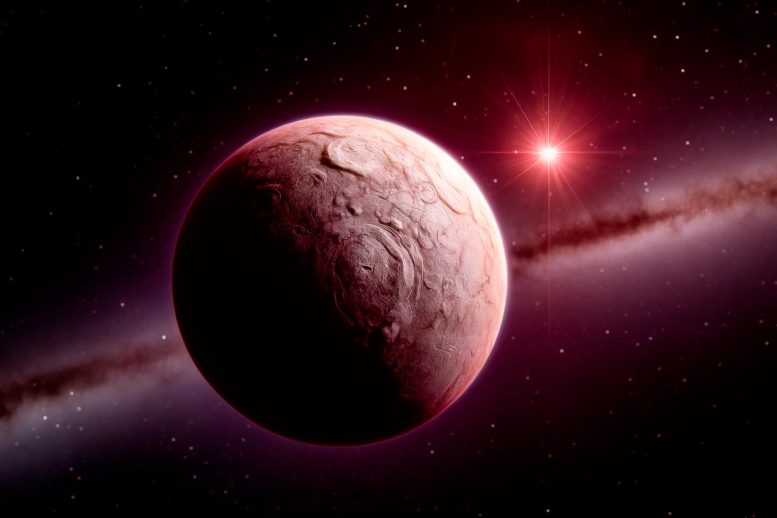
New planet SPECULOOS-3b, discovered orbiting an ultracool dwarf star, likely lacks an atmosphere and offers unique insights into exoplanetary geology. Credit: SciTechDaily.com
Astronomers have discovered a new Earth-sized planet, SPECULOOS-3b, orbiting a cold, Jupiter-sized star 55 light years away. Unlike Earth, this planet likely lacks an atmosphere due to intense radiation from its close proximity to the star, offering a unique unobstructed view for direct geological study of its surface composition and history.
A new planet orbiting a small cold star, a mere 55 light years away has been discovered by astronomers at MIT, the University of Liège, and elsewhere. Although the nearby exoplanet is similar to Earth in its size and rocky composition, that’s where the similarities end. The key difference is that this new world is likely missing an atmosphere.
In a paper published on May 15, 2024, in the journal Nature Astronomy, the researchers confirm the detection of SPECULOOS-3b, an Earth-sized, likely airless planet that the team discovered using a network of telescopes as part of the SPECULOOS (Search for Planets EClipsing ULtra-cOOl Stars) project.
The new planet orbits a nearby ultracool dwarf — a type of star that is smaller and colder than the sun. Ultracool dwarf stars are thought to be the most common type of star in our galaxy, though they are also the faintest, making them difficult to spot in the night sky.
SPECULOOS is a ground-based transit survey consisting of six identical 1-m robotic telescopes. The immediate goal of the project is to detect temperate terrestrial planets transiting nearby ultracool dwarfs, which could be amenable for atmospheric research with the next generation of telescopes. SPECULOOS Northern Observatory (SNO) is currently composed of one 1m-aperture telescope called Artemis. It is located at the Teide Observatory (Canary Islands, Spain) and has been operational since June 2019. Credit: D. Padrón
The ultracool dwarf that hosts the new planet is about one-tenth the size of, and 1,000 times dimmer than, the sun. The star is more similar in size to Jupiter and is twice as cold as the sun. Nevertheless, the dwarf star radiates an enormous amount of energy onto the planet’s surface due to the planet’s extremely close proximity: SPECULOOS-3b circles its star in just 17 hours. One year on the new planet, then, is shorter than one day on Earth.
Because it is so close to its star, the planet is blasted with 16 times more radiation per second compared to what the Earth receives from the sun. The team believes that such intense and relentless exposure has likely vaporized any atmosphere that the planet once held, leaving it an airless, exposed, blistering ball of rock.
If the planet lacks an atmosphere, scientists might soon be able to zero in on exactly what type of rocks are on its surface and even what sort of geological processes shaped its landscape, such as whether the planet’s crust experienced magma oceans, volcanic activity, and plate tectonics in its past.
“SPECULOOS-3b is the first planet for which we can consider moving toward constraining surface properties of planets beyond the solar system,” says study co-author Julien de Wit, associate professor of planetary sciences at MIT. “With this world, we could basically start doing exoplanetary geology. How cool is that?”
The study’s MIT co-authors include research scientists Benjamin Rackham and Artem Burdanov, along with lead author Michel Gillon of the University of Liège and colleagues from collaborating institutions and observatories around the world.
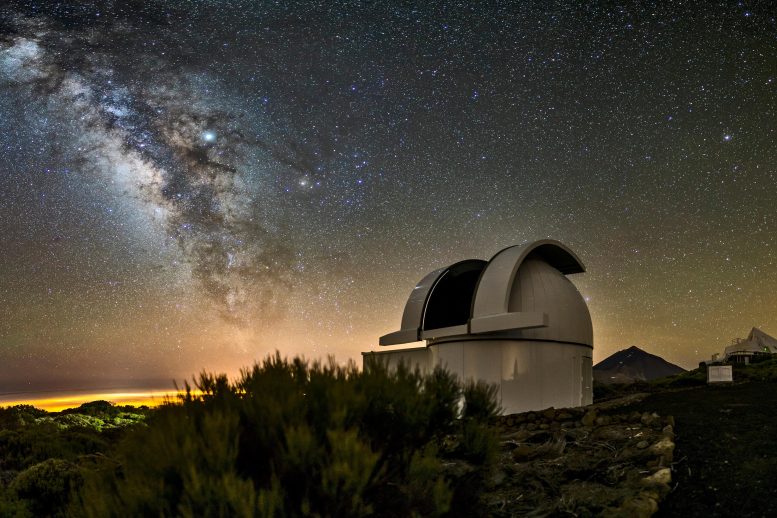
SPECULOOS-3b is a nearby, Earth-sized planet that may lack an atmosphere. It was discovered using a network of telescopes as part of the SPECULOOS (Search for Planets EClipsing ULtra-cOOl Stars) project. Pictured is the MIT Artemis telescope, part of the SPECULOOS network. Credit: D. Padrón
Lining Up
Astronomers observed the first inklings of the new planet in 2021, with observations taken by SPECULOOS — a network of six robotic, 1-meter telescopes (four in the Southern Hemisphere, and two in the Northern Hemisphere) that continuously observe the sky for signs of planets orbiting around ultracool dwarf stars. SPECULOOS is the parent project of the TRAPPIST (TRAnsiting Planets and PlanetesImals Small Telescope-South) survey, which discovered seven terrestrial planets — several potentially habitable — around a small cold star named TRAPPIST-1.
SPECULOOS aims to observe about 1,600 nearby ultracool dwarf stars. As these stars are small, any planets that orbit and cross in front of them should momentarily block their light, by a more noticeable amount compared to planets that orbit around larger, brighter stars. Ultracool dwarf stars, then, could give astronomers a better view of any planets that they host.
In 2021, a telescope in SPECULOOS’ network picked up some inconclusive signs of a transit, in front of one ultracool dwarf star about 55 light years away. Then in 2022, a close monitoring with MIT’s Artemis telescope changed the game.
“While there were structures in the 2021 data that didn’t look convincing, the 2022 Artemis data really got our attention,” recalls MIT’s Artem Burdanov, who manages the SPECULOOS Northern Observatory. “We started to analyze one clear transit-like signal in the Artemis data, quickly decided to launch a campaign around this star, and then things just started lining up.”
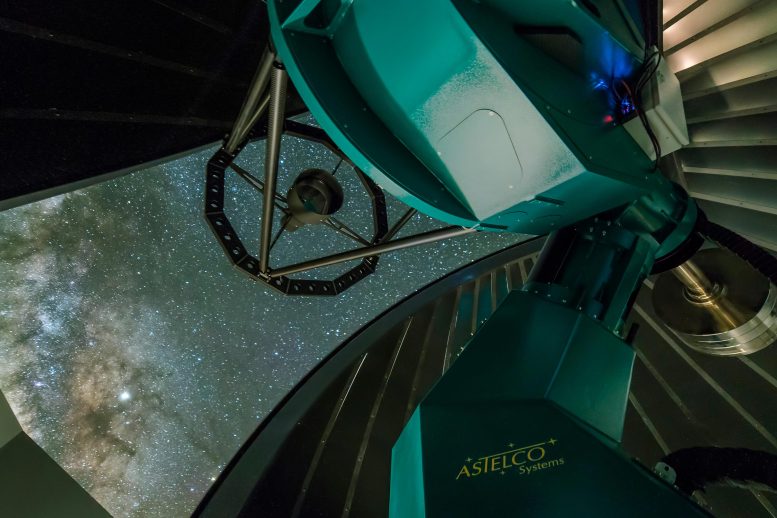
In 2021, a telescope in SPECULOOS’ network picked up some inconclusive signs of a transit, in front of one ultracool dwarf star about 55 light years away. Then in 2022, a close monitoring with MIT’s Artemis telescope, pictured here, changed the game. Credit: D. Padrón
Dark Like the Moon
The team zeroed in on the star with MIT’s Artemis telescope, the rest of the SPECULOOS network, and several other observatories. The multipronged observations confirmed that the star did indeed host a planet, which appeared to orbit every 17 hours. Judging from the amount of light it blocked with each crossing, the scientists estimate that the planet is about the size of the Earth.
They were then able to estimate certain properties of the star and the planet based on analyses of the star’s light taken by MIT’s Benjamin Rackham, who has led a campaign using the Magellan telescopes in Chile and the NASA Infrared Telescope Facility (IRTF) in Hawaii to analyze the light from nearby ultracool dwarf stars.
“We can say from our spectra and other observations that the star has a temperature of about 2,800 kelvins, it is about 7 billion years old — not too young, and not too old — and it is moderately active, meaning that it flares quite a lot,” Rackham says. “We think the planet must not have an atmosphere anymore because it would easily have been eroded away by the activity of the host star that’s basically constantly flaring.”
Without an atmosphere, then, what might one see if they were to look up from the planet’s surface?
“If there’s no atmosphere, there would be no blue sky or clouds — it would just be dark, like on the surface of the moon,” Rackham offers. “And the ‘sun’ would be a big, purplish-red, spotted, and flaring star that would look about 18 times as big as the sun looks to us in the sky.”
Because the planet lacks an atmosphere and is relatively close by, the team says that SPECULOOS-3b is an ideal candidate for follow-up studies by NASA’s James Webb Space Telescope (JWST), which is powerful enough to parse the star’s light and discern more details of both the star and the planet. With JWST’s observations, the team hopes to be able to identify details of the planet’s surface, which would be a first in the field of exoplanetary studies.
“We think that the planet is nearly as hot as Venus, so not habitable,” Rackham says. “It’s not hot enough to have a lava surface. It should be solid rock. But depending on how bright that rock is, it could be recently resurfaced due to plate tectonics or volcanic activity, or it could be a planet that’s been eroded by space weathering and has a much darker surface. Going forward, we should be able to distinguish between some interesting scenarios for the surface of the planet.”
For more on this discovery:
- Astronomers Uncover Earth-Sized Exoplanet Just 55 Light-Years Away
- Robotic Telescopes Find New Earth-Sized World Orbiting an Ultra-Cool Star
Reference: “Detection of an Earth-sized exoplanet orbiting the nearby ultracool dwarf star SPECULOOS-3” by Michaël Gillon, Peter P. Pedersen, Benjamin V. Rackham, Georgina Dransfield, Elsa Ducrot, Khalid Barkaoui, Artem Y. Burdanov, Urs Schroffenegger, Yilen Gómez Maqueo Chew, Susan M. Lederer, Roi Alonso, Adam J. Burgasser, Steve B. Howell, Norio Narita, Julien de Wit, Brice-Olivier Demory, Didier Queloz, Amaury H. M. J. Triaud, Laetitia Delrez, Emmanuël Jehin, Matthew J. Hooton, Lionel J. Garcia, Clàudia Jano Muñoz, Catriona A. Murray, Francisco J. Pozuelos, Daniel Sebastian, Mathilde Timmermans, Samantha J. Thompson, Sebastián Zúñiga-Fernández, Jesús Aceituno, Christian Aganze, Pedro J. Amado, Thomas Baycroft, Zouhair Benkhaldoun, David Berardo, Emeline Bolmont, Catherine A. Clark, Yasmin T. Davis, Fatemeh Davoudi, Zoë L. de Beurs, Jerome P. de Leon, Masahiro Ikoma, Kai Ikuta, Keisuke Isogai, Izuru Fukuda, Akihiko Fukui, Roman Gerasimov, Mourad Ghachoui, Maximilian N. Günther, Samantha Hasler, Yuya Hayashi, Kevin Heng, Renyu Hu, Taiki Kagetani, Yugo Kawai, Kiyoe Kawauchi, Daniel Kitzmann, Daniel D. B. Koll, Monika Lendl, John H. Livingston, Xintong Lyu, Erik A. Meier Valdés, Mayuko Mori, James J. McCormac, Felipe Murgas, Prajwal Niraula, Enric Pallé, Ilse Plauchu-Frayn, Rafael Rebolo, Laurence Sabin, Yannick Schackey, Nicole Schanche, Franck Selsis, Alfredo Sota, Manu Stalport, Matthew R. Standing, Keivan G. Stassun, Motohide Tamura, Yuka Terada, Christopher A. Theissen, Martin Turbet, Valérie Van Grootel, Roberto Varas, Noriharu Watanabe and Francis Zong Lang, 15 May 2024, Nature Astronomy.
DOI: 10.1038/s41550-024-02271-2
This research was supported, in part, by the European Research Council, the Simons Foundation, and the Heising-Simons Foundation.



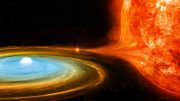


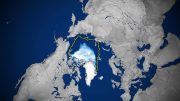


Be the first to comment on "Astronomers Discover Nearby Earth-Sized Planet With No Atmosphere"